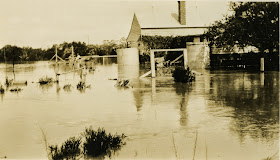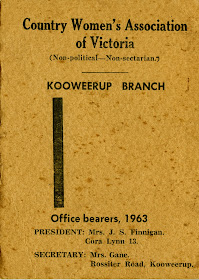The
Presbyterian Church and the Methodist Church used to hold services at the Cora
Lynn Hall from around the 1920s to 1960.
Most people attended every Sunday regardless of which religion they
were. The average congregation was around 25. Sunday School started first at 1.30pm and
Church was at 2.30pm.
Dad
and his sisters and brother all went to Sunday School and Church at Cora Lynn, initially
driven by horse and jinker, until the family got their first car in 1948.
Cora Lynn Sunday
School 1948
Back row - Fourth
from left is Frank Rouse, far right is Nancy Rouse, to her left is her sister
Dorothy and in front of her is another sister, Daphne. Do you recognize anyone?
Apart
from Cora Lynn there was a Methodist Church at Five Mile and one at Garfield and
Modella. Garfield and Modella were serviced by the Drouin Minister and Cora
Lynn and Five Mile by the Koo-Wee-Rup Minister. The only Methodist Ministers Mum
and Dad can remember is a Mr Rosewarne and the Rev Blainey - the father of
historian Geoffrey Blainey. There was also a Presbyterian Church at Iona and
Bunyip.
The
Presbyterian Minister from around 1953 was the Reverend Quentin Huckson. He
lived in Bunyip with his wife Peggy and their four children - Judith, John,
Peter and Andrew. Rev Huckson had a
service at Bunyip every week; then went to Iona which was an 11.30am service
then alternate weeks did Cora Lynn and Longwarry at 2.30pm. He also conducted a
monthly service at Tonimbuk and a service at Longwarry North. He drove to these
services in a Peugot 203 and Dad said he was happy to talk about his car for
hours. It was an unusual car in this area as it was the first foreign car they
had seen in the district.
The
Reverend Huckson left the Parish on August 25 1957 but the week before he left
on August 18 Mum says he ‘rounded up’ all the babies in the area that were due
to be christened and did a ‘mass baptism’ of about 12 babies all at once at
Iona, including my sister Megan and our cousin Bruce Forte.
Before
the next Presbyterian Minister came there was a period of about 16 months where
retired ministers filled in. They often came by train the night before and then
on the Sunday had at least three services to conduct. The next minister was the
Reverend Ron Traill who came around the end of 1958 and almost immediately
closed down Tonimbuk and Longwarry North Churches, but Cora Lynn lasted a bit
longer and closed at the end of 1960.
Getting
back to Cora Lynn - the big occasions at Cora Lynn were the Harvest Festival
and the Sunday School picnic. The Harvest Festival would receive two to three
tons of potatoes, onions, pumpkins etc that would all be taken to the
Presbyterian Kildonan or Canterbury Babies Home or similar Methodist Homes. The
Sunday School picnic was held at Glen Cromie and many of the children got there
on the back of a truck owned by Ern Wilkinson.
This
brings us to the Cora Lynn congregation - here is a list of people that Dad and
Mum remembers attending the Cora Lynn Church. Ern and Elsie Wilkinson and their
son Keith; Jim and Mabel MacDonald and their children Lorna, Jack, Bob and
Joyce; Mrs Whitta and her son Donald; Mrs Julia Clapperton and her son Keith;
Dan and Corrie Kinsella; Norman and Lorna Kinsella; Mrs Aileen Higgins of Toner
Road - she had 5 or 6 children including Merna, Maurice, Ron, Joy and Wayne;
Mrs Jocie Clay who lived on the Nine Mile and had young children; Mrs Nell
Leamon, the wife of Clarrie the Scout Master. After Mr Leamon passed away she
married Cr Dick Wakenshaw, the father of Bob and Don; the Slater family - the children
were Euan and twins Andrew and Mary; Jack and Grace Huntingford and children
Garry, Pam and Gwenda; Harry and Florence Huntingford and children Elaine and
Jim; Mrs Harker and her children Frank and Joyce; Mrs Pearl Townley, Mrs
McKenzie (wife of Les), Alan and Audrey Reid and Win Reid, who was the Sunday
school teacher. Win was a cousin of Alan and Audrey. Sorry, we don’t know all the first names.
There
was also the Cora Lynn Combined Church Ladies Guild which continued on for
several years after the services were stopped at Cora Lynn.
This is the Cora-Lynn
Combined Churches Ladies Guild c.1965
Left
to Right - Mabel McDonald (nee Wilkinson), Elsie Wilkinson, Rene Huntingford (nee Stephenson), Mrs Benham, Pearl Townley,
Audrey Reid, Nell Wakenshaw, Mrs McKenzie, Grace Huntingford, Corrie Kinsella
and Eva Rouse (nee Weatherhead, my grandma).
I am indebted to Bruce Stephenson for identifying Rene Huntingford, as we had her listed as unknown.
I am indebted to Bruce Stephenson for identifying Rene Huntingford, as we had her listed as unknown.


















































